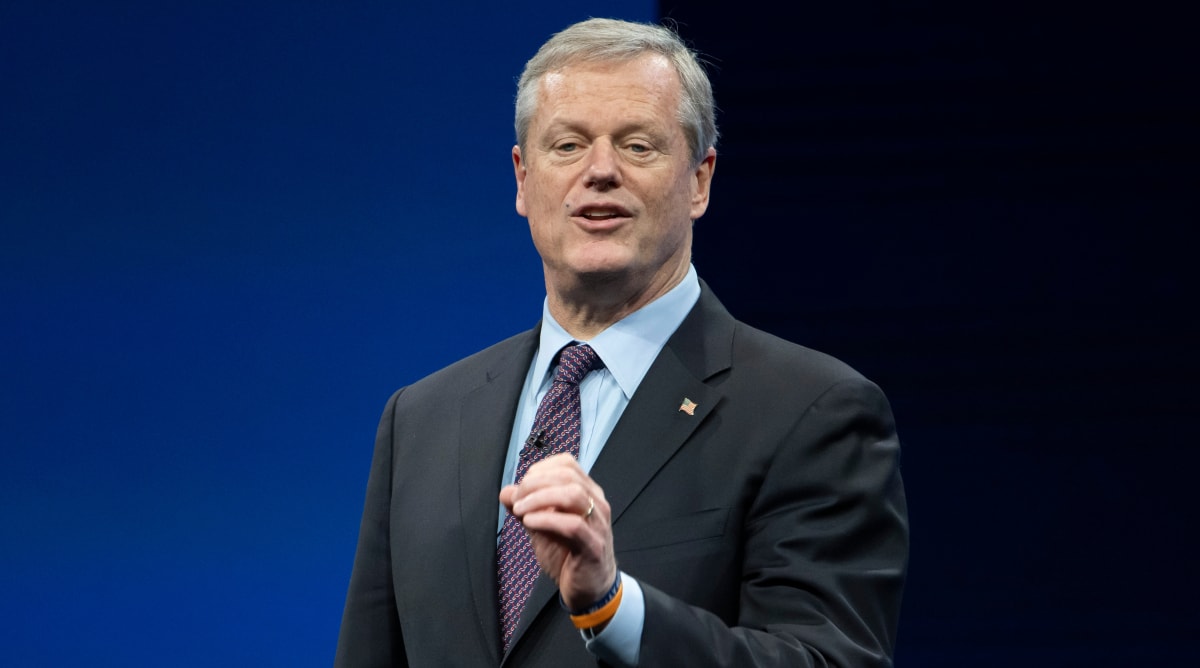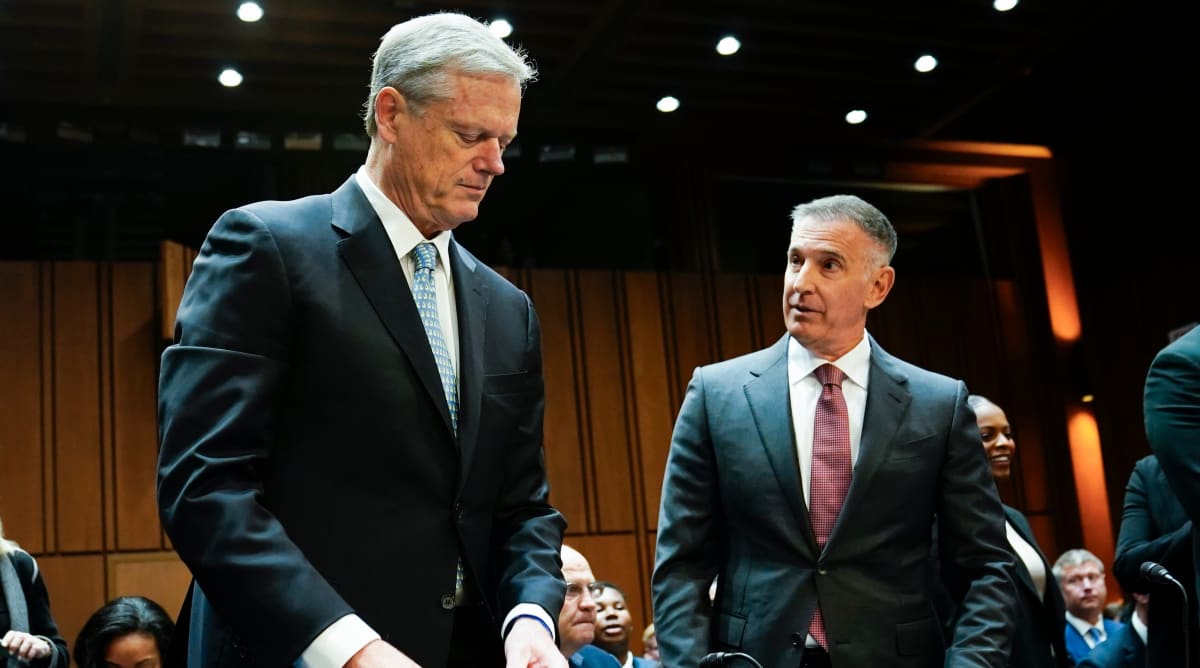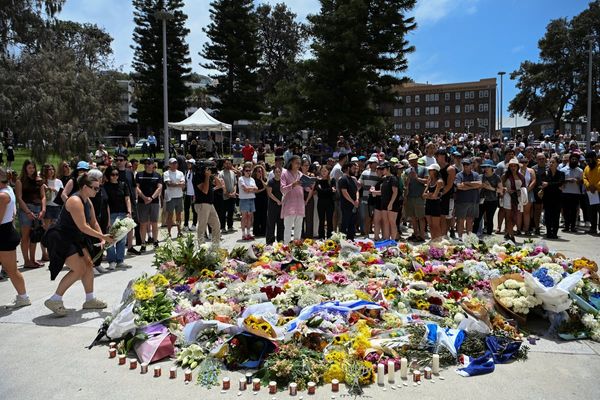NCAA president Charlie Baker has proposed a fundamental alteration to the highest level of Division I college athletics. It would be an opt-in scenario for member schools to become part of a new subdivision within Division I, and would be a chance that has been clamored for by many within the industry to give the schools at the highest level more autonomy, while preventing them from splintering off and creating their own organization. It calls for schools to “invest at least $30,000 per year into an enhanced educational trust fund for at least half of the institution’s eligible student-athletes,” and is something of a signal to Congress that the organization is not asleep at the wheel. Baker has stressed that this is in the very early stages and is at this point just a proposal, so what does it all mean? You’ve got questions, and we’ve got (some) answers.

Darren Abate/AP
Question: How many Division I schools can reasonably be expected to opt in for a new subdivision?
Baker used the number “100” on a couple of occasions Wednesday during a Q&A at the Sports Business Journal college sports symposium in Las Vegas—his first public comments on the new proposal. There are 133 schools in the FBS portion of Division I. In 2024, 68 of those schools will be in the Atlantic Coast, Big 12, Big Ten and Southeastern conferences. Two more are in limbo as they fight to keep the Pac-12 name (and revenue), and presumably would want to be part of that subdivision. The other 30 or so could come from some combination of the American Athletic Conference, Mountain West, Sun Belt, Mid-American and Conference USA. But there also are basketball-first conferences that would have to weigh their options, most notably the Big East.
Q: Why is this coming out now?
Well, the immediate answer is because of the sit-down in Las Vegas. A broader meeting is scheduled with Baker and the conference commissioners later this month and if he wanted to make the type of announcement he did, it’s well timed before that and then the NCAA convention in early January, where thousands of officials from every school in every division will descend on Phoenix for meetings and legislative sessions. This will certainly be the hot topic during the meetings.
Q: Did Baker seek input from conference and campus leaders before putting his plan out in public?
Apparently not, at not least from a wide range of constituents. Most, if not all, commissioners were in the dark about the contents of Baker’s letter, to their irritation. SEC commissioner Greg Sankey publicly lamented that on a panel in Las Vegas on Wednesday: “Why wasn’t our Board brought into this conversation sooner?” But others were not so miffed. Southland commissioner Chris Grant told Sports Illustrated.
“I’m excited. And that’s probably not a word you hear a lot at the FCS level. You know, you’d think you’d be more scared of what was to come, but [I’m] excited because now you’re opening up more avenues to be at the forefront of student athlete wellness right and benefits and what we’re offering them to only enhance their experience. So, so long, we’ve been held back by some of the NCAA [with] bylaws and things that were permissible and what’s not. I have athletic directors chomping at the bit to provide a more enhanced athlete experience through their collectors or other fundraising avenues,” Grant says. “I’m ecstatic that we finally, as a membership and as an organization, are willing to take a leap of faith and go down a road that we’ve all been too nervous to talk about coming to existence.”
There is a notion from some outside of the power conference level of Division I, including Grant, that it makes no sense to hold back programs that are already playing on a different level. Mostly, campus leaders who responded positively to Baker’s letter are pleased the NCAA is doing something.
“I am excited and optimistic by the letter that was put out by Charlie Baker,” Michigan regent Jordan Acker says. “I think it’s an enormous step forward and recognizing the space that we’re actually in and it gives Charlie Baker, the conference commissioners and other decision-makers the opportunity to be true transformative leaders in the space. And I think this is the basis of continuing negotiations with Congress. That would hopefully lead to something productive that both student athletes, college administrators, and others can be happy about while preserving some semblance of the system that governs college athletics.”
Q: How much money would a typical university in that subdivision have to pay out to 50% of its athletes?
There was some confusion and skepticism throughout the industry about whether there will be a cap to that number and how the $30,000 number was arrived at.
“That’s a permissive standard,” Baker said. “And it’s a standard that’s designed to establish the minimum that it would take, if you want to be in the so-called subdivision. People could do more.”
Baker also said this would not create a revenue framework, which Baker said could create a thorny Title IX issue. Back-of-napkin math estimates put the average FBS school’s number of athletes at about 400. If $30,000 is the minimum payout to have that number, the estimate is about $6 million per year. In Las Vegas on Wednesday, Baker used much bigger numbers, estimating that schools with 800 to 900 athletes would be paying $12 million to $15 million annually. He might be right; the benchmarks of $30,000 per year and 50% of a school’s athletes are both minimums, under his plan.

Jack Gruber/USA TODAY
Q: Would this plan slow or stop the lobbying of Congress to craft legislation that protects college sports from antitrust legislation and lawsuits?
Not at all. The NCAA and its member schools still very much want antitrust exemptions, do not want to classify athletes as employees and do not want to be forced into revenue sharing related to media rights income.
“I don’t know if they should or will get [antitrust legislation],” Acker says. “But I do believe that this is the basis for some legislation, where the NCAA gives up some of its control and some of the way that they’ve done business in exchange for some congressional protection or clarification. That allows them to continue to operate instead of having these decisions made for by judges.”
Baker’s plan is in addition to those efforts, which were ramped up last week with several prominent conference commissioners visiting Washington, D.C., to push Congress for action. A commissioner theorized to SI that Baker’s proposal could be seen as “an attempt to incentivize Congress to move, if they now see the NCAA is more serious.”
Sam Ehrlich, a lawyer and professor in Legal Studies in Business at Boise State argues it may be harder to get relief from lawsuits because of what they’re proposing.
“Antitrust, I think, is going to be a little easier for them to clear. I wouldn’t say it’s easy for them to clear, I wouldn’t go nearly that far. I wouldn’t even say in my mind that they even clear that burden at this point. If anything, I think [the NCAA’s argument against making athletes employees] is hurt by the news. Because now that you’re having this direct compensation, regardless of what form it’s in, it’s a lot harder to argue that they’re not employees under the standard that the NCAA has argued.”
Q: Have any of the legal parties responded to Baker’s proposal?
Paul McDonald, lawyer for the plaintiffs in Johnson v. NCAA, a case in which the organization is being sued by former athletes for the right to run a multifactor test that would hopefully deem college athletes employers of their schools and the NCAA jointly, and able to make at least the minimum wage based on the hours they practice and compete.
“I’m always a little bit skeptical of anything that singles the athletes out for not being student employees, like the other kids are on campus who are doing nonacademic work right for the university benefits,” McDonald says. “Why don’t you want them to have the same protections and the same treatment the other kids have? Now if you want to give them something on top of that fantastic, because they surely deserve it in terms of what they generate for the university. Not in terms of directors, in terms of direct revenue.”
Q: What happens to collectives if the payments to athletes move more directly under the auspices of the schools themselves?
It may not be a bad thing for college athletics to wrest some of the control in athlete compensation away from collectives, which are seen by some as an unintended consequence of the way NIL began operating back in 2021. Not all in the world are unhappy with things moving away from those third parties according to Drew Esler, vice president of operations at The 1870 Society, a collective affiliated with Ohio State.
“I think there are a lot of bad actors in the space,” Esler says. “And it takes a lot of trust to commit to a third party. That’s not officially under the umbrella of a university. I think that kind of mitigates a lot of the risk of some of the situations we’ve seen in the past. And then in terms of the scalability and the ability to do more corporate deals, if you bring it in-house you already have partners such as Learfield. They have the capabilities to really flesh out some of these marketing deals, which I think at the end of the day is best for the athletes. You know, we’re just a small collective, very few people. So, having a dedicated team and not having to go for trademark and licensing and that can kind of just flow through the university. I think it’s a win-win, especially for some of the bigger schools such as Ohio State.”
Q: What about Title IX?
Part of getting athlete compensation back in-house rather than farmed out to third-party collectives also has to do with Title IX, the federal legislation that requires schools to provide equal opportunity based on sex. Where it applies to college athlete compensation is that it’s unclear if collectives have to abide by the legislation because they’re third parties, and in many cases private businesses. We just don’t know enough now about how this will be implemented to draw that conclusion.
Q: When could this be implemented?
Nothing in the NCAA governance structure ever moves quickly, so don’t expect this to happen anywhere close to overnight.
“My expectation is, at the convention, not to have a fully baked plan, but in order to put a timeline in place, that we’re not just floating this out, like the transformation committee,” Grant said of a recent NCAA committee which appeared to have a mandate to bring sweeping change to the organization, only to take a long time to not really implement much change at all.
“A lot of great people and high-level folks took away from their jobs to create change, and we’ve slowly implemented some things. So what I truly want to see in January is us being consistent and no one looking to hold this up, but where we work towards solutions on how we get this done. … I’m also a realist in that trying to do things overnight in this governance structure can be a challenge, especially when you have so many bylaws that truly need to be revisited to make sure we’re not shooting ourselves in the foot.”







